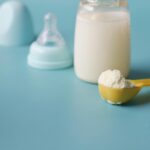I’ve seen firsthand how safe breast milk storage can transform the breastfeeding journey. Whether you’re returning to work, dealing with latch issues, building a freezer stash, or simply want the flexibility of having someone else feed your baby occasionally, knowing how to properly pump and store your breast milk is an invaluable skill.
I still remember pumping for my first baby while balancing my midwifery practice, storing precious ounces in my hospital locker between helping other mothers bring their babies into the world. Since then, I’ve refined my techniques through four more children and countless clients. Let me share what I’ve learned about keeping your liquid gold safe and nutritious.
Why Proper Pumping and Storing Matters
When it comes to your breast milk, quality preservation is everything. Unlike formula, breast milk is a living substance, packed with antibodies, beneficial bacteria, enzymes, hormones, and perfectly balanced nutrition that changes to meet your baby’s needs.
The way you handle, pump, and store this remarkable fluid affects:
- Nutritional quality: Some vitamins and living components degrade with improper storage
- Antibacterial properties: Fresh milk has the strongest immune benefits
- Taste and acceptance: Improperly stored milk can develop a soapy or metallic taste that some babies reject
- Safety: Following guidelines prevents bacterial growth that could make your baby ill
As one mother I worked with said after her baby happily accepted her properly stored milk, “It feels like I can be in two places at once—at work and still nourishing my baby.” That’s exactly what good pumping and storage practices allow.
Essential Equipment for Safe Breast Milk Storage
Before diving into techniques, let’s talk tools. Having the right equipment makes safe breast milk storage significantly easier.
Choosing the Right Breast Pump
Not all pumps are created equal, and the right one depends on your specific needs:
- Hospital-grade pumps: These powerful, multi-user pumps are ideal for establishing supply, pumping for premature babies, or overcoming supply issues. They’re typically available for rental.
- Personal electric pumps: Perfect for regular pumping, such as when returning to work. Double pumping saves time and can increase milk output.
- Manual pumps: Great for occasional use, travel, or as a backup. They’re quiet, portable, and give you complete control over suction.
- Silicone manual pumps/milk collectors: These simple devices collect letdown from one breast while you nurse on the other—passive collection that adds up!
I remember being determined to use only a manual pump with my second baby to save money. After three days of hand cramping and frustration, I invested in a quality double electric pump. The time saved and increased output made it worth every penny—a lesson I now share with all expectant mothers planning to pump.
According to the Centers for Disease Control and Prevention, proper pump cleaning between sessions is just as important as milk storage. A pump contaminated with bacteria can transfer those pathogens to your expressed milk.
Storage Containers: What Works Best
You have several options for storing your liquid gold:
- Breast milk storage bags: Space-saving, pre-sterilized, and designed specifically for freezing breast milk. Look for double-zipper seals and sturdy material.
- Hard plastic containers: BPA-free plastic or glass containers with tight-fitting lids work well, especially for refrigerated milk.
- Mason jars: For refrigerated storage, small glass mason jars are sustainable and don’t absorb odors.
- Silicone storage bags: Reusable and environmentally friendly, though more expensive initially.
Whatever container you choose should be clean, food-grade, and free from BPA or other concerning chemicals. I prefer using storage bags for freezing and glass containers for refrigerated milk I’ll use within 24 hours.
One client creatively repurposed an ice cube tray to freeze milk in 1-ounce portions, perfect for adding to baby food later. These small hacks can make your pumping journey more efficient and less wasteful.
Mastering the Art of Pumping
Successful pumping is both technique and mindset. Here’s how to make your pumping sessions more productive:
Preparing for Successful Expression
Setting yourself up for pumping success starts before you ever turn on your pump:
- Create a comfortable space: Whether at home or work, find a clean, private area where you can relax.
- Stay hydrated and nourished: Have water and snacks within reach.
- Use breast massage: Gentle massage before pumping increases output.
- Apply warm compresses: Heat encourages milk flow.
- Look at photos or videos of your baby: This triggers your letdown reflex.
- Establish a routine: Your body responds better to consistency.
I’ll never forget pumping in a tiny supply closet when I returned to my midwifery practice after having my third child. By bringing a small photo of my baby, a water bottle, and taking five deep breaths before starting, I transformed that closet into a productive pumping sanctuary.
Proper Pumping Technique for Maximum Output
Safe breast milk storage begins with proper expression:
- Center flanges properly: Your nipple should move freely in the tunnel without rubbing.
- Start with low suction: Gradually increase to a level that’s comfortable but effective.
- Mimic baby’s rhythm: Start with quick, short pulses to trigger letdown, then switch to slower, deeper pulls.
- Pump long enough: 15-20 minutes is typical, but follow your body’s cues.
- Consider power pumping: One hour of alternating pumping and resting (10 minutes on, 10 minutes off) can boost supply.
- Hands-on pumping: Gentle compression of your breast while pumping can increase output by up to 50%.
When teaching a young mother who was pumping for her premature twins, I showed her the hands-on pumping technique. Her milk output nearly doubled immediately, bringing tears to her eyes. “I had no idea my hands could make such a difference,” she told me. It’s these simple techniques that often create breakthrough moments.
The Complete Guide to Safe Breast Milk Storage
Now for the heart of our topic: how to handle and store your expressed milk to maintain its quality and safety.
Proper Handling After Expression
Once you’ve pumped, follow these steps:
- Clean hands are essential: Always wash thoroughly before handling milk or pump parts.
- Label immediately: Note the date and amount on storage containers.
- Store milk in small portions: 2-4 ounces matches typical feeding amounts and reduces waste.
- Leave room for expansion: Milk expands when frozen, so leave about an inch of space.
- Chill promptly: Refrigerate or freeze milk within 4 hours of pumping, sooner in warm environments.
- Consider combining milk: You can add cooled milk to already refrigerated milk from the same day.
I advise mothers to prepare storage containers before they start pumping so they can transfer milk immediately without fumbling with labels and bags while holding bottles of precious milk. This small preparation step has saved countless ounces from accidental spills over the years.
Safe Breast Milk Storage Guidelines: Temperature and Timing
How long can you store breast milk? Follow these evidence-based guidelines:
- Room temperature (up to 77°F/25°C): 4 hours optimal, up to 6-8 hours acceptable in very clean conditions
- Insulated cooler with ice packs: 24 hours
- Refrigerator (39°F/4°C): 4 days optimal, 5-8 days acceptable in very clean conditions
- Freezer compartment inside refrigerator: 2 weeks
- Freezer with separate door: 3-6 months
- Deep freezer (-4°F/-20°C or colder): 6-12 months
According to La Leche League International, the fresher the milk, the better, as some anti-infective properties decrease over time. However, even frozen milk maintains most of its nutritional benefits and is far superior to formula.
One mother I worked with developed a color-coded system using different colored electrical tape on her storage containers—blue for milk pumped in the morning (higher in proteins that promote alertness) and red for evening milk (higher in sleep-inducing components). She would then match the milk type to the time of day her baby would consume it.
Organizing Your Stored Milk
Efficient organization prevents waste and confusion:
- First in, first out: Use the oldest milk first.
- Store in the back of the freezer: Temperature is more stable there.
- Use milk storage bins: Keep milk organized by date.
- Consider flash-freezing: Freeze bags flat on a cookie sheet first for efficient storage.
- Track your inventory: Keep a simple log of what’s stored where.
When my fourth baby arrived and my freezer already contained milk from my third child (who was still nursing occasionally), clear labeling became critical. Masking tape and permanent marker became my best friends for preventing mix-ups.
Thawing and Using Stored Breast Milk
The final step in safe breast milk storage is proper thawing and warming.
Thawing Frozen Milk Safely
Never microwave breast milk or use high heat, which destroys valuable components and can create dangerous hot spots. Instead:
- Transfer from freezer to refrigerator: Thaw overnight (preferable method).
- Place in warm water: For quicker thawing, place the container in a bowl of warm (not hot) water.
- Hold under running warm water: Start cool and gradually increase temperature.
- Use within 24 hours after thawing: Once completely thawed, treat like fresh refrigerated milk.
- Never refreeze thawed milk: This can introduce bacteria and further degrade quality.
One clever mother I supported used a simple system: each night before bed, she moved tomorrow’s milk from freezer to refrigerator, establishing a routine that ensured milk was always safely thawed when needed.
Addressing Common Questions About Stored Milk
Over my years of practice, these questions come up frequently:
- “My milk smells soapy. Is it bad?”: Milk with a soapy smell has likely experienced lipase activation. It’s safe to use if baby accepts it. For future pumping, scald fresh milk before storing to deactivate lipase.
- “The milk separated in storage. Should I throw it out?”: Separation is normal! Gently swirl (don’t shake vigorously) to mix the cream back in.
- “Can I add fresh milk to already frozen milk?”: Only if you cool the fresh milk first, and only if it’s from the same pumping day.
- “How do I transport milk safely?”: Use an insulated cooler with ice packs. Minimize the number of times you open it to maintain temperature.
- “My baby refuses thawed milk. What can I do?”: Try mixing thawed milk with fresh milk gradually, warming to different temperatures, or using milk with lower storage time.
I recall one determined mother who discovered her excess lipase issue after freezing several weeks’ worth of milk. Rather than discarding her “liquid gold,” she experimented with mixing small amounts into baby cereal once her child started solids. Nothing wasted!
Special Circumstances in Breast Milk Storage
Some situations require additional consideration:
Pumping for Premature or Hospitalized Babies
If you’re pumping for a vulnerable infant:
- Follow hospital guidelines: These may be stricter than general recommendations.
- Consider colostrum harvesting: Small syringes of early milk can be particularly valuable.
- Label with extra information: Note if you’re taking any medications.
- Track pumping sessions meticulously: This helps monitor your production.
When supporting a mother with twins in the NICU, we set up a simple pumping log that tracked not just volume but the time of day and which breast produced what amount. This data helped her optimize her pumping schedule and production.
Donating Excess Breast Milk
If you’re blessed with abundance, consider donation:
- Contact milk banks: They have specific collection and storage protocols.
- Undergo screening: This ensures your milk is suitable for vulnerable infants.
- Follow stricter guidelines: Milk banks typically have more rigorous handling requirements.
- Keep donation milk separate: Use dedicated containers and labeling.
I’ve both donated milk and helped mothers navigate the donation process. The knowledge that your excess can help premature or ill infants is incredibly rewarding.
Troubleshooting Common Pumping and Storage Challenges
Even with the best practices, challenges arise in safe breast milk storage:
- Low output during pumping: Try different flange sizes, massage techniques, or relaxation methods.
- Clogged ducts: Warm compresses, gentle massage, and frequent emptying help.
- Contamination concerns: When in doubt, throw it out. If milk may have been contaminated, it’s better to be safe.
- Storage space limitations: Consider prioritizing newer milk and using the oldest milk in creative ways, like milk baths or baby’s cereal.
- Power outages: Keep freezer doors closed and add ice. Milk will stay frozen in a full freezer for about 48 hours if unopened.
After a hurricane left us without power for three days, I salvaged most of my frozen milk by keeping the freezer sealed and packing it with extra ice. The few packages that partially thawed went into the refrigerator for immediate use—a lesson in emergency preparedness!
Final Thoughts on Safe Breast Milk Storage
Pumping and storing your breast milk is both science and art. While following safety guidelines is crucial, remember that your journey is unique. What works perfectly for one mother might need adjustment for another.
I often tell new mothers that there’s a learning curve to pumping, just as there is to breastfeeding directly. Be patient with yourself as you develop your routine and system. Each session gets easier, and the gift you’re giving your baby—your unique liquid gold, perfectly designed for their needs—is worth the effort.
Whether you’re pumping exclusively, occasionally, or building a stash for future needs, proper handling ensures your milk retains its remarkable properties. From one mother to another, I can assure you that the day will come when you’ll look back on your pumping days with pride, knowing you navigated this chapter of motherhood with knowledge and care.



